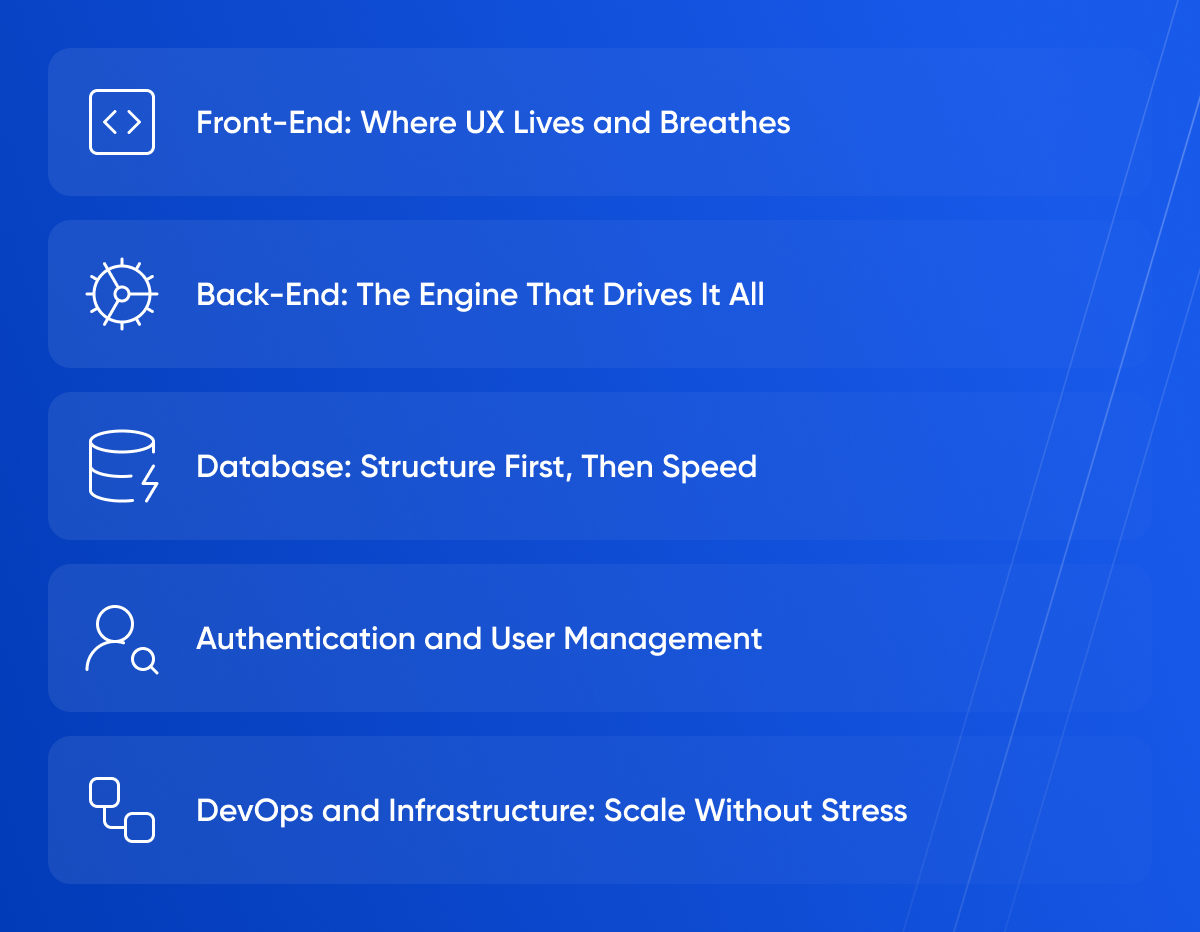Your startup’s tech stack is more than just a list of frameworks and services — it’s the foundation your product, team, and scalability all depend on. The wrong decision can leave you drowning in technical debt or scrambling to rebuild when you hit growth. The right one can accelerate your launch, reduce bugs, and create a platform your team can iterate on with confidence.
For early-stage SaaS startups, the challenge isn’t just choosing fast. It’s choosing smart. You want speed without sacrificing flexibility, and simplicity without painting yourself into a corner.
At Movadex, we’ve helped founders design and deploy SaaS products across industries — each with their own stack preferences and constraints. But underneath every unique case lies a shared truth: your stack should reflect your product’s goals, your team’s strengths, and your stage of growth.
Here’s how to approach your SaaS stack with clarity.

Front-End: Where UX Lives and Breathes
The front-end is your user’s first — and most consistent — touchpoint. A clunky or inconsistent interface erodes trust immediately.
In 2025, most SaaS startups turn to either React or Vue.js. Both are mature, component-based frameworks with huge ecosystems. React wins for flexibility, community, and integrations. Vue offers a more opinionated structure and a smoother learning curve for smaller teams.
For mobile? React Native or Flutter allow you to extend your SaaS offering to mobile without building two separate codebases. If your product is dashboard-heavy, start with web — then expand as your users demand it.
Use UI libraries like Tailwind CSS, Chakra UI, or Material UI to speed up development without compromising design consistency.
Back-End: The Engine That Drives It All
The back-end is where your app’s logic, data processing, and scalability live. Here, the balance is between speed to build and power to scale.
Node.js remains a top choice for early-stage teams, especially when paired with frameworks like Express or NestJS. It’s great for quick iteration, has a huge talent pool, and integrates well with modern tooling.
For more structured, enterprise-ready projects, Django (Python) or Ruby on Rails are still fantastic. They come with batteries included — meaning built-in solutions for common problems like authentication, admin dashboards, and ORM integration.
Serverless approaches are also becoming increasingly popular. Platforms like Vercel (for front-end) or AWS Lambda and Firebase Functions allow for auto-scaling, low ops overhead, and efficient cost models in early stages.
Database: Structure First, Then Speed
Your choice of database sets the tone for how you store, query, and relate data. And in SaaS, data is everything.
PostgreSQL is the gold standard for a reason: flexible, relational, battle-tested. It’s the default for most modern SaaS startups.
MongoDB is great for products where data structure isn’t rigid, or where speed and simplicity trump strict schema enforcement. But as your SaaS matures, you’ll likely want the consistency of SQL.
For real-time apps, you might integrate Redis (for caching) or Firebase Realtime DB (for collaborative features), layered alongside your primary store.
Authentication and User Management
Don’t reinvent login systems. Use proven tools.
Firebase Auth, Auth0, Supabase Auth, or Clerk are all solid choices depending on your use case. If you’re targeting enterprise clients, ensure support for SSO, MFA, and custom user roles.
From the start, build your user model to scale: include metadata, usage tiers, and permission structures. This will save painful migrations down the line.
DevOps and Infrastructure: Scale Without Stress
For hosting, Vercel and Netlify simplify front-end deployments with zero-config workflows, built-in CI/CD, and preview environments. On the backend, consider Heroku for early simplicity or AWS/GCP for more control as you scale.
Use Docker from day one if you plan to build a team. It standardizes environments and avoids the dreaded "but it works on my machine" dilemma.
Set up monitoring with tools like LogRocket, Sentry, or Datadog. Even if you’re small, it’s easier to catch issues early — before users report them.
Internal Tools and Automation
As your SaaS grows, you’ll need internal dashboards, support tools, and admin access. Don’t wait until your support team is swamped.
Use tools like Retool, Forest Admin, or build a simple internal dashboard using your existing front-end stack. Automate where possible — webhook-based notifications, usage tracking, churn signals, and billing alerts.
Connect these tools to your CRM, support system, and email marketing platforms. The smoother your ops, the faster you can respond to growth.
Final Thought: The Best Stack is the One That Serves Your Users
Founders often obsess over their stack like it’s the product. But your stack is a means to an end: delivering consistent, scalable value to users. The most elegant backend means nothing if the UX is clunky. The most beautiful front-end won’t save a broken data model.
Pick the stack that helps your team move fast, test confidently, and learn quickly. Favor tools with great docs, active communities, and proven adoption. Avoid black-box solutions you can’t scale or debug.
At Movadex, we help SaaS startups architect tech stacks that are as smart as their founders — lean enough to launch fast, and robust enough to scale gracefully.
When in doubt, build for today — but leave space for tomorrow.




